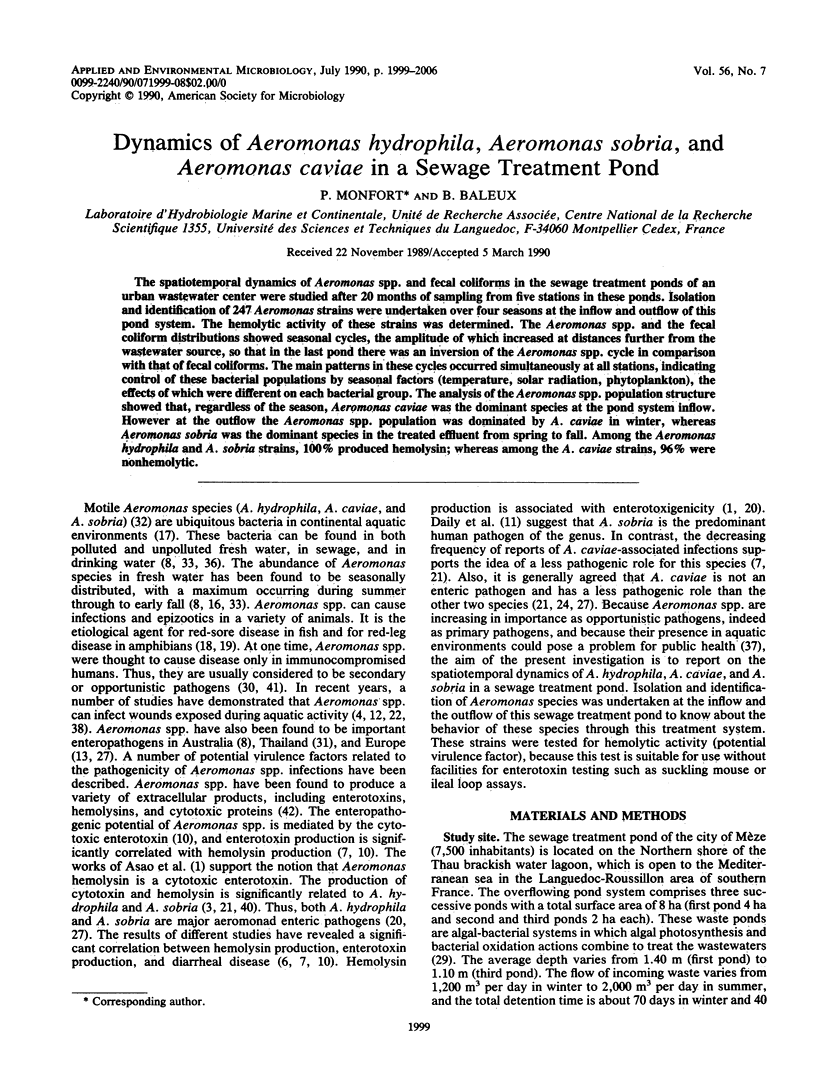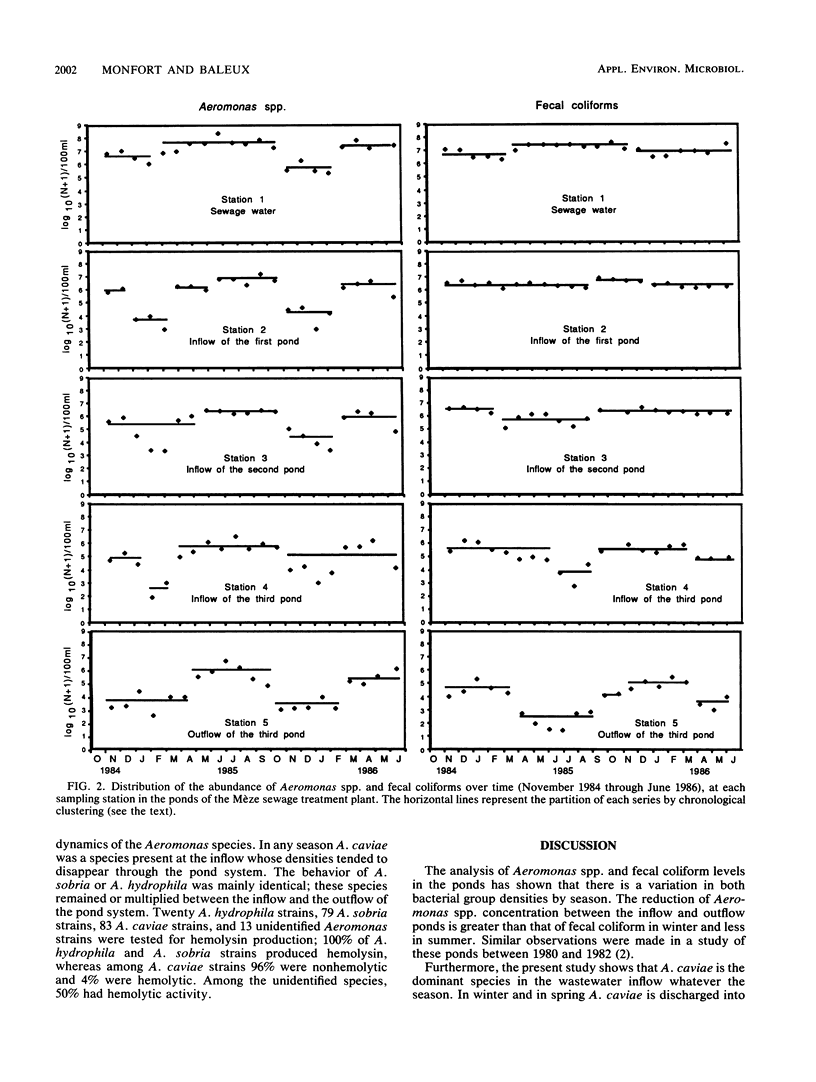Abstract
The spatiotemporal dynamics of Aeromonas spp. and fecal coliforms in the sewage treatment ponds of an urban wastewater center were studied after 20 months of sampling from five stations in these ponds. Isolation and identification of 247 Aeromonas strains were undertaken over four seasons at the inflow and outflow of this pond system. The hemolytic activity of these strains was determined. The Aeromonas spp. and the fecal coliform distributions showed seasonal cycles, the amplitude of which increased at distances further from the wastewater source, so that in the last pond there was an inversion of the Aeromonas spp. cycle in comparison with that of fecal coliforms. The main patterns in these cycles occurred simultaneously at all stations, indicating control of these bacterial populations by seasonal factors (temperature, solar radiation, phytoplankton), the effects of which were different on each bacterial group. The analysis of the Aeromonas spp. population structure showed that, regardless of the season, Aeromonas caviae was the dominant species at the pond system inflow. However at the outflow the Aeromonas spp. population was dominated by A. caviae in winter, whereas Aeromonas sobria was the dominant species in the treated effluent from spring to fall. Among the Aeromonas hydrophila and A. sobria strains, 100% produced hemolysin; whereas among the A. caviae strains, 96% were nonhemolytic.
Full text
PDF







Images in this article
Selected References
These references are in PubMed. This may not be the complete list of references from this article.
- Asao T., Kinoshita Y., Kozaki S., Uemura T., Sakaguchi G. Purification and some properties of Aeromonas hydrophila hemolysin. Infect Immun. 1984 Oct;46(1):122–127. doi: 10.1128/iai.46.1.122-127.1984. [DOI] [PMC free article] [PubMed] [Google Scholar]
- Barer M. R., Millership S. E., Tabaqchali S. Relationship of toxin production to species in the genus Aeromonas. J Med Microbiol. 1986 Dec;22(4):303–309. doi: 10.1099/00222615-22-4-303. [DOI] [PubMed] [Google Scholar]
- Beaune J., Llorca G., Gonin A., Brun Y., Fleurette J., Neidhart J. P. Phlegmon nécrotique de la main, point de départ d'une septicémie due à Aeromonas hydrophila. Démonstration de l'origine ichtyologique de l'infection. Nouv Presse Med. 1978 Apr 8;7(14):1206–1207. [PubMed] [Google Scholar]
- Brauer C., Scheftel J. M., Rihn B., Monteil H. Isolement de Aeromonas hydrophila dans les diarrhées. Caractérisation des souches entérotoxinogènes et relations cliniques. Ann Biol Clin (Paris) 1985;43(5):725–731. [PubMed] [Google Scholar]
- Burke V., Robinson J., Beaman J., Gracey M., Lesmana M., Rockhill R., Echeverria P., Janda J. M. Correlation of enterotoxicity with biotype in Aeromonas spp. J Clin Microbiol. 1983 Nov;18(5):1196–1200. doi: 10.1128/jcm.18.5.1196-1200.1983. [DOI] [PMC free article] [PubMed] [Google Scholar]
- Burke V., Robinson J., Gracey M., Peterson D., Partridge K. Isolation of Aeromonas hydrophila from a metropolitan water supply: seasonal correlation with clinical isolates. Appl Environ Microbiol. 1984 Aug;48(2):361–366. doi: 10.1128/aem.48.2.361-366.1984. [DOI] [PMC free article] [PubMed] [Google Scholar]
- Cavari B. Z., Allen D. A., Colwell R. R. Effect of temperature on growth and activity of Aeromonas spp. and mixed bacterial populations in the Anacostia River. Appl Environ Microbiol. 1981 Apr;41(4):1052–1054. doi: 10.1128/aem.41.4.1052-1054.1981. [DOI] [PMC free article] [PubMed] [Google Scholar]
- Cumberbatch N., Gurwith M. J., Langston C., Sack R. B., Brunton J. L. Cytotoxic enterotoxin produced by Aeromonas hydrophila: relationship of toxigenic isolates to diarrheal disease. Infect Immun. 1979 Mar;23(3):829–837. doi: 10.1128/iai.23.3.829-837.1979. [DOI] [PMC free article] [PubMed] [Google Scholar]
- Daily O. P., Joseph S. W., Coolbaugh J. C., Walker R. I., Merrell B. R., Rollins D. M., Seidler R. J., Colwell R. R., Lissner C. R. Association of Aeromonas sobria with human infection. J Clin Microbiol. 1981 Apr;13(4):769–777. doi: 10.1128/jcm.13.4.769-777.1981. [DOI] [PMC free article] [PubMed] [Google Scholar]
- Delbeke E., Demarcq M. J., Roubin C., Baleux B. Contamination aquatique de plaies par Aeromonas sobria après bain de rivière. Presse Med. 1985 Jun 8;14(23):1292–1292. [PubMed] [Google Scholar]
- Figura N., Marri L., Verdiani S., Ceccherini C., Barberi A. Prevalence, species differentiation, and toxigenicity of Aeromonas strains in cases of childhood gastroenteritis and in controls. J Clin Microbiol. 1986 Mar;23(3):595–599. doi: 10.1128/jcm.23.3.595-599.1986. [DOI] [PMC free article] [PubMed] [Google Scholar]
- Fliermans C. B., Gorden R. W., Hazen T. C., Esch G. W. Aeromonas distribution and survival in a thermally altered lake. Appl Environ Microbiol. 1977 Jan;33(1):114–122. doi: 10.1128/aem.33.1.114-122.1977. [DOI] [PMC free article] [PubMed] [Google Scholar]
- Hazen T. C., Fliermans C. B., Hirsch R. P., Esch G. W. Prevalence and distribution of Aeromonas hydrophila in the United States. Appl Environ Microbiol. 1978 Nov;36(5):731–738. doi: 10.1128/aem.36.5.731-738.1978. [DOI] [PMC free article] [PubMed] [Google Scholar]
- Hazen T. C., Raker M. L., Esch G. W., Fliermans C. B. Ultrastruct of red-sore lesions on largemouth bass (Micropterus salmoides): associattion of the ciliate Epistylis sp. and the bacterium Aeromonas hydrophila. J Protozool. 1978 Aug;25(3 Pt 2):351–355. doi: 10.1111/j.1550-7408.1978.tb03901.x. [DOI] [PubMed] [Google Scholar]
- Hird D. W., Diesch S. L., McKinnell R. G., Gorham E., Martin F. B., Kurtz S. W., Dubrovolny C. Aeromonas hydrophila in wild-caught frogs and tadpoles (Rana pipiens) in Minnesota. Lab Anim Sci. 1981 Apr;31(2):166–169. [PubMed] [Google Scholar]
- Janda J. M. Biochemical and exoenzymatic properties of Aeromonas species. Diagn Microbiol Infect Dis. 1985 May;3(3):223–232. doi: 10.1016/0732-8893(85)90034-3. [DOI] [PubMed] [Google Scholar]
- Janda J. M., Reitano M., Bottone E. J. Biotyping of Aeromonas isolates as a correlate to delineating a species-associated disease spectrum. J Clin Microbiol. 1984 Jan;19(1):44–47. doi: 10.1128/jcm.19.1.44-47.1984. [DOI] [PMC free article] [PubMed] [Google Scholar]
- Joseph S. W., Daily O. P., Hunt W. S., Seidler R. J., Allen D. A., Colwell R. R. Aeromonas primary wound infection of a diver in polluted waters. J Clin Microbiol. 1979 Jul;10(1):46–49. doi: 10.1128/jcm.10.1.46-49.1979. [DOI] [PMC free article] [PubMed] [Google Scholar]
- Kaper J. B., Lockman H., Colwell R. R., Joseph S. W. Aeromonas hydrophila: ecology and toxigenicity of isolates from an estuary. J Appl Bacteriol. 1981 Apr;50(2):359–377. doi: 10.1111/j.1365-2672.1981.tb00900.x. [DOI] [PubMed] [Google Scholar]
- Kirov S. M., Rees B., Wellock R. C., Goldsmid J. M., Van Galen A. D. Virulence characteristics of Aeromonas spp. in relation to source and biotype. J Clin Microbiol. 1986 Nov;24(5):827–834. doi: 10.1128/jcm.24.5.827-834.1986. [DOI] [PMC free article] [PubMed] [Google Scholar]
- Legendre P., Baleux B., Troussellier M. Dynamics of pollution-indicator and heterotrophic bacteria in sewage treatment lagoons. Appl Environ Microbiol. 1984 Sep;48(3):586–593. doi: 10.1128/aem.48.3.586-593.1984. [DOI] [PMC free article] [PubMed] [Google Scholar]
- Monfort P., Baleux B. Evaluation de deux milieux de culture pour l'isolement et le dénombrement des Aeromonas mobiles dans différents types d'eau. C R Acad Sci III. 1988;307(9):523–527. [PubMed] [Google Scholar]
- Mégraud F. Incidence and virulence of Aeromonas species in feces of children with diarrhea. Eur J Clin Microbiol. 1986 Jun;5(3):311–316. doi: 10.1007/BF02017787. [DOI] [PubMed] [Google Scholar]
- Picard B., Arlet G., Goullet P. Septicémies à Aeromonas hydrophila. Aspects épidémiologiques. Quinze observations. Presse Med. 1984 May 5;13(19):1203–1205. [PubMed] [Google Scholar]
- Pitarangsi C., Echeverria P., Whitmire R., Tirapat C., Formal S., Dammin G. J., Tingtalapong M. Enteropathogenicity of Aeromonas hydrophila and Plesiomonas shigelloides: prevalence among individuals with and without diarrhea in Thailand. Infect Immun. 1982 Feb;35(2):666–673. doi: 10.1128/iai.35.2.666-673.1982. [DOI] [PMC free article] [PubMed] [Google Scholar]
- Rogol M., Sechter I., Grinberg L., Gerichter C. B. Pril-xylose-ampicillin agar, a new selective medium for the isolation of Aeromonas hydrophila. J Med Microbiol. 1979 May;12(2):229–231. doi: 10.1099/00222615-12-2-229. [DOI] [PubMed] [Google Scholar]
- Schubert R. H. Die Relation von aerogenen zu anaerogenen Aeromonaden der "Hydrophila-Punctata-Gruppe" in Fliessgewässern in Abhängigkeit von der Abfallstoffbelastung. Zentralbl Bakteriol Orig B. 1975 May;160(3):237–245. [PubMed] [Google Scholar]
- Seidler R. J., Allen D. A., Lockman H., Colwell R. R., Joseph S. W., Daily O. P. Isolation, enumeration, and characterization of Aeromonas from polluted waters encountered in diving operations. Appl Environ Microbiol. 1980 May;39(5):1010–1018. doi: 10.1128/aem.39.5.1010-1018.1980. [DOI] [PMC free article] [PubMed] [Google Scholar]
- Thonnon J., Rives J. M., Laniel D. Infection du cuir chevelu à Aeromonas hydrophila. Particularités. Presse Med. 1987 Jun 27;16(25):1244–1244. [PubMed] [Google Scholar]
- Turnbull P. C., Lee J. V., Miliotis M. D., Van de Walle S., Koornhof H. J., Jeffery L., Bryant T. N. Enterotoxin production in relation to taxonomic grouping and source of isolation of Aeromonas species. J Clin Microbiol. 1984 Feb;19(2):175–180. doi: 10.1128/jcm.19.2.175-180.1984. [DOI] [PMC free article] [PubMed] [Google Scholar]
- Von Graevenitz A., Mensch A. H. The genus aeromonas in human bacteriology report of 30 cases and review of the literature. N Engl J Med. 1968 Feb 1;278(5):245–249. doi: 10.1056/NEJM196802012780504. [DOI] [PubMed] [Google Scholar]
- Watson I. M., Robinson J. O., Burke V., Gracey M. Invasiveness of Aeromonas spp. in relation to biotype, virulence factors, and clinical features. J Clin Microbiol. 1985 Jul;22(1):48–51. doi: 10.1128/jcm.22.1.48-51.1985. [DOI] [PMC free article] [PubMed] [Google Scholar]



